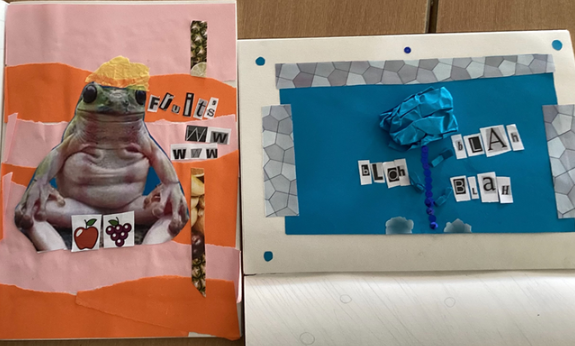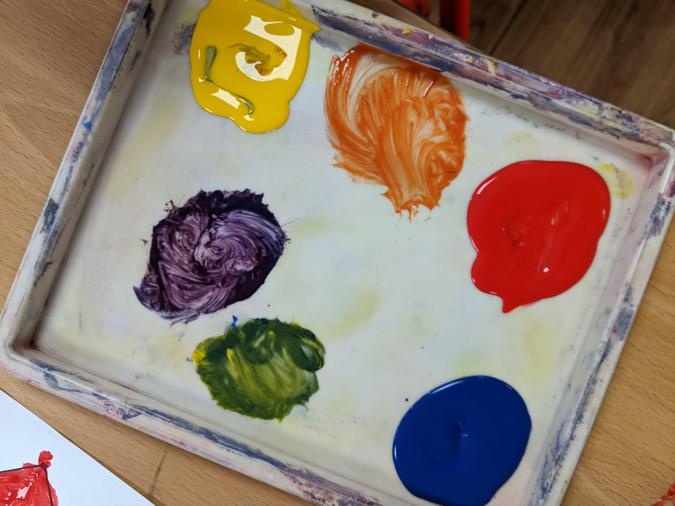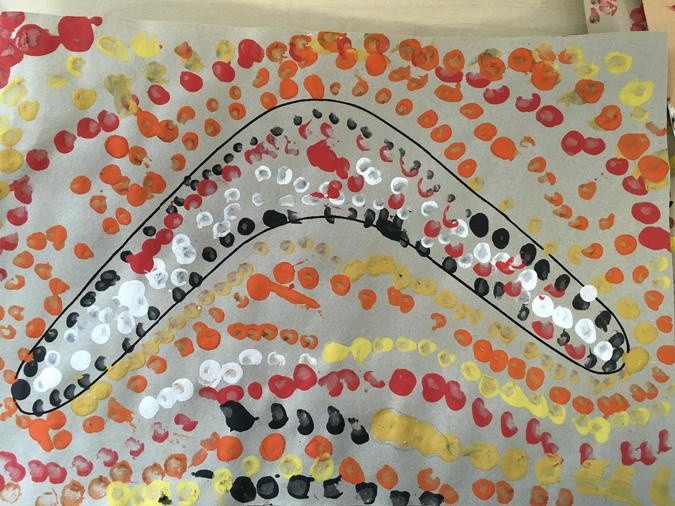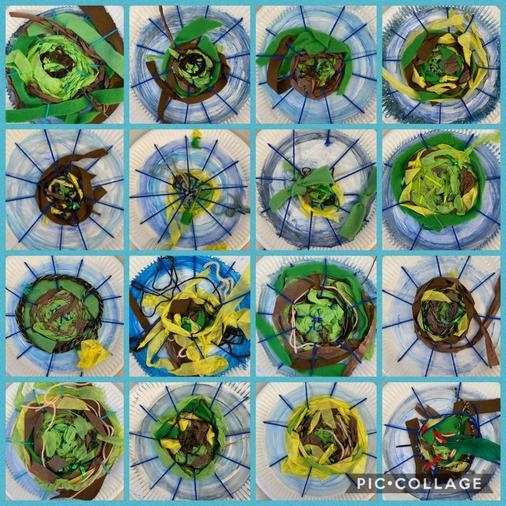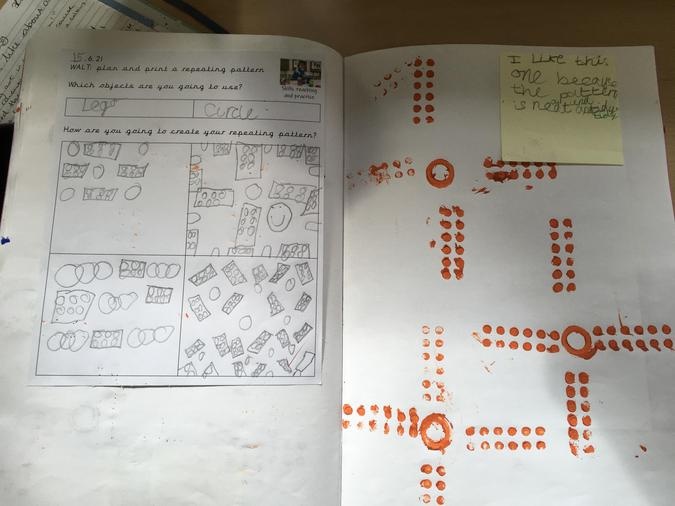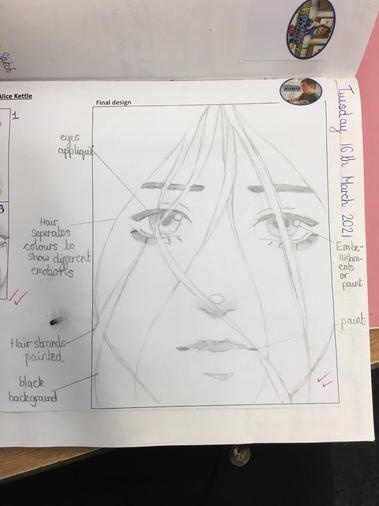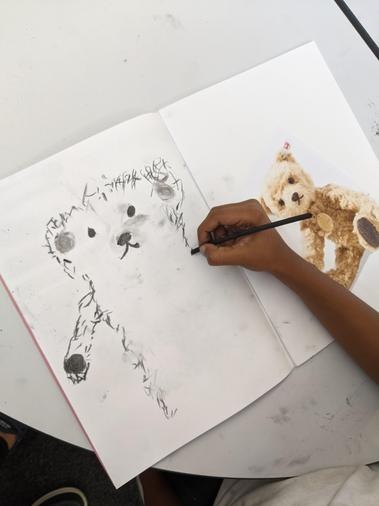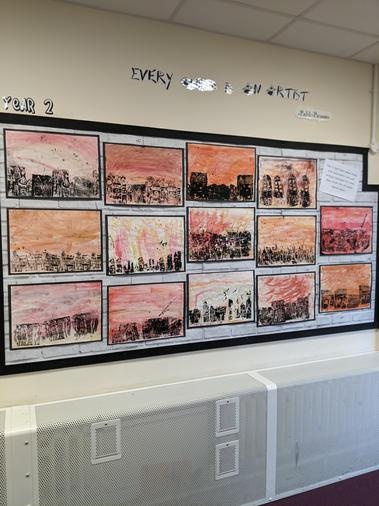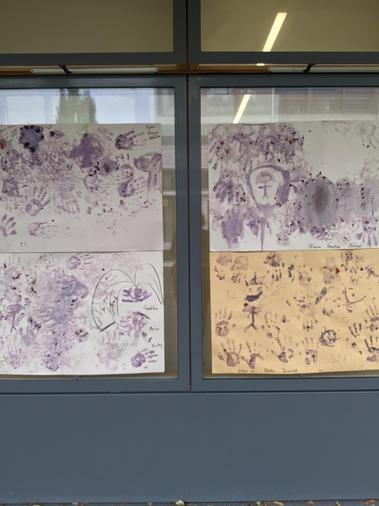Art

Curriculum Leaders: Sarah Clouter (EYFS/KS1) and Laura Oswald (KS2)
Mrs Clouter and Mrs Oswald are our art leaders and are responsible for this curriculum area. This means ensuring we teach an ambitious curriculum, supporting our teachers to implement our curriculum through high-quality lessons and checking that lessons are helping our children to know more, remember more and do more.
Purpose of study
Art, craft and design embody some of the highest forms of human creativity. A high-quality art and design education should engage, inspire and challenge pupils, equipping them with the knowledge and skills to experiment, invent and create their own works of art, craft and design. As pupils progress, they should be able to think critically and develop a more rigorous understanding of art and design. They should also know how art and design both reflect and shape our history, and contribute to the culture, creativity and wealth of our nation.
Aims
The national curriculum for art and design aims to ensure that all pupils:
- produce creative work, exploring their ideas and recording their experiences
- become proficient in drawing, painting, sculpture and other art, craft and design techniques
- evaluate and analyse creative works using the language of art, craft and design
- know about great artists, craft makers and designers, and understand the historical and cultural development of their art forms.
Intent
We are setting out to help our pupils be ...
- Skillful - Children become proficient with a diverse range of skills and techniques.
- Excited - Children love to produce creative artwork and explore their own ideas.
- Resilient - Children are resilient and enjoy art even when it is not perfect.
- Cultured - Children learn about great artists from a variety of cultures throughout history and in the world today.
Implementation
We will do this by ensuring ...
- A variety of experiences - Children gain real-life experiences through visitors and trips.
- Children have a broad and balanced curriculum - A broad and exciting curriculum that is engaging for children.
- Giving children time - Allow children time to make and explore without expectations first.
- Children have a broad and balanced curriculum - Content is taught progressively, looking at different artists in each year group.
Impact
We will have made a difference when ...
- Children value the arts - Children see value in the arts and see artistic careers as viable options.
- Children enjoy the arts - Children enjoy their art learning and are proud of what they can produce.
- Children are brave - Children are free to make mistakes and try new ideas.
- Children can show what they know - All children are taught a varied curriculum and show a clear understanding of threshold concepts.
Our children will be taught to...
Year R
-
In Reception Year, children are encouraged to engage in a variety of art activities to develop their creativity and explore the world around them. They are given access to a range of materials, tools and techniques that are safe and appropriate for their age group.
-
The aim is for children to experiment with these materials, tools and techniques in order to learn about colour, design, texture, form and function. This helps to develop their fine motor skills, hand-eye coordination and their understanding of spatial relationships.
-
As they work, children are encouraged to talk about their creations, explaining the process they have used. This helps to develop their communication and language skills, as well as their ability to think critically about their work.
-
When it comes to sharing their creations, children are given the opportunity to display them in the classroom or to take them home to show their families. This helps to build their confidence and pride in their work, as well as providing a sense of accomplishment.
Key Stage 1
In Key Stage 1, each autumn term begins with the colour project Mix It. The teaching of this project in Years 1 and 2 enables children to be introduced to and then revisit colour theory and provides plentiful opportunities for children to explore primary and secondary colours.
Year 1 begins by exploring themes directly related to the children themselves, such as their facial features, the surrounding natural world and their local community.
|
|
|
In Year 2, the projects expand children’s artistic horizons by allowing them to study a more comprehensive range of artists, artistic movements, and creative techniques.
|
|
|
Lower Key Stage 2
Each autumn term in Lower Key Stage 2 begins with the colour project Contrast and Complement. In Years 3 and 4, the teaching of this project enables children to build on their previous understanding of colour and further develop their expertise by studying theory.
In Year 3, children expand their experiences to study a broader range of art forms, artists and genres. They also begin to study art from specific and diverse periods of history, including prehistoric pottery and Roman mosaics. Other genres studied in Year 3 build on previous techniques learned in Key Stage 1, including more complex techniques in printmaking, drawing, painting and textiles.
|
|
|
|
|
|
|
|
In Year 4, children develop more specialised techniques in drawing, painting, printmaking and sculpture. They explore ways in which ancient cultures have influenced art and crafts by studying, for example, medieval weaving techniques and the religious significance of Islamic art.
|
|
|
Upper Key Stage 2
Upper Key Stage 2 In Upper Key Stage 2, each autumn term begins with the colour project Tints, Tones and Shades. Teaching these projects in Years 5 and 6 enables children to build on their previous understanding of colour theory and develop further expertise with colour by studying tonal variations and more complex colour charts.
In Year 5, children develop and combine more complex artistic techniques in a range of genres, including drawing, painting, printmaking and sculpture. Children continue to build on their understanding of other historical periods and cultures by studying the ancient Chinese art form of taotie and the significance of the Expressionist movement.
|
|
|
|
In Year 6, children are encouraged to work more independently in projects like Environmental Artists and Distortion and Abstraction. Such projects require them to consider more conceptual representations of personal, environmental, social or political messaging. Children explore diversity in art by studying the projects Inuit and Trailblazers, Barrier Breakers.
|
|
|
|
Units of Learning
Year 1
 |
Year 1 - AutumnMixing Colours This essential skills and knowledge project teaches children about basic colour theory by studying the colour wheel and colour mixing. It includes exploring primary and secondary colours and how artists use colour in their artwork. |
 |
Year 1 - AutumnFunny Faces & Fabulous Features This teaches the concept of the portrait and how the collage technique can be used to make a portrait. |
 |
Year 1 - SpringRain & Sunrays This project teaches children about collagraph printing, including how to develop a motif to make single and repeated prints. |
 |
Year 1 - SummerStreet View This project teaches children about artwork depicting streets and buildings and focuses on the work of the American pop artist, James Rizzi. They create a 3-D mural based on Rizzi's work. |
Year 2
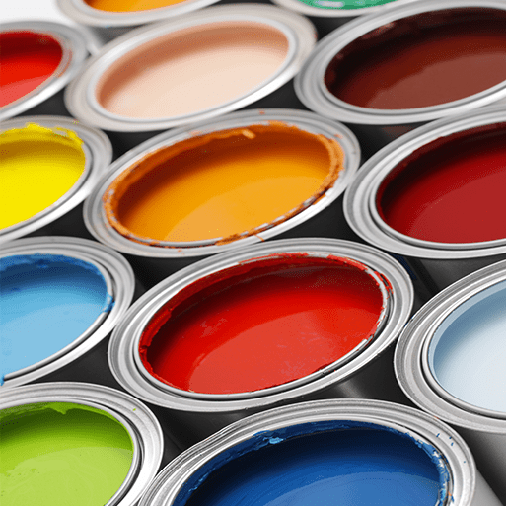 |
Year 2 - AutumnExploring Colour This essential skills and knowledge project teaches children about colour theory by studying the colour wheel and colour mixing. It includes an exploration of primary and secondary colours, hues and how artists use colour in their artwork. |
 |
Year 2 - SpringFlower Head This project teaches children about the visual elements of flowers, including shape, texture, colour, pattern and form. They also explore various artistic methods, including drawing, printmaking and 3D forms, using paper and clay. |
 |
Year 2 - SummerStill Life This project teaches children about the work of significant still-life artists and still-life techniques. They explore a wide variety of still-lifes and learn about the use of colour and composition. They also create still-life arrangements and artwork. |
Year 3
 |
Year 3 - AutumnColour Theory This essential skills and knowledge project teaches children about colour theory by studying the colour wheel and colour mixing. It includes exploring tertiary colours, warm and cool colours, complementary colours, analogous colours and how artists use colour in their artwork. |
 |
Year 3 - AutumnPrehistoric Pots This project teaches children about Bell Beaker pottery. It allows the children to explore different clay techniques, which they use to make and decorate a Bell Beaker-style pot. |
 |
Year 3 - SpringPeople and Places This project teaches children about the genre of figure drawing. They study the figure drawings and urban landscapes of the artist LS Lowry and create artwork in his style to show scenes from their school. |
 |
Year 3 - SummerMosaic Masters This project teaches children about the history of mosaics before focusing on the colours, patterns and themes found in Roman mosaics. The children learn techniques to help them design and make a mosaic border tile. |
Year 4
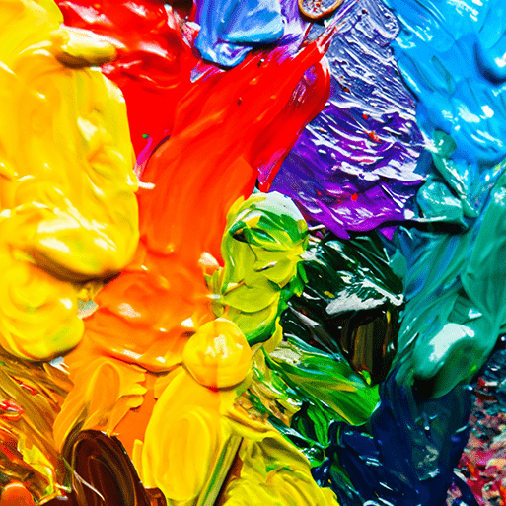 |
Year 4 - AutumnWarm and Cool Colours This essential skills and knowledge project teaches children about colour theory by studying the colour wheel and colour mixing. It includes exploring warm and cool colours, Aboriginal art and how artists use colour in their artwork. |
 |
Year 4 - AutumnWarp & Weft This project teaches children about the art form of weaving and how it has developed over time, including the materials and techniques required to create woven patterns and products. |
 |
Year 4 - SpringVista This project teaches children about the techniques that artists use when composing landscape images, such as colour and atmosphere. |
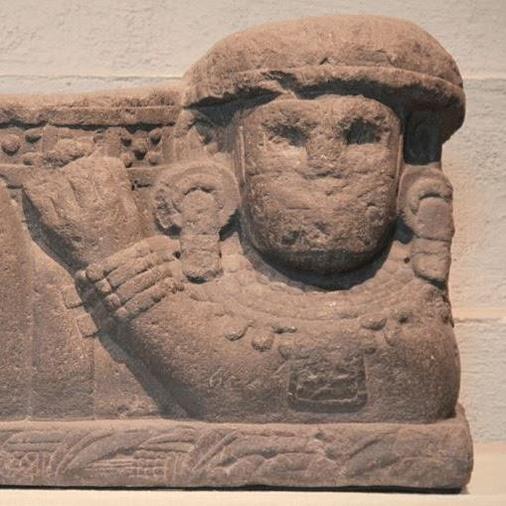 |
Year 4 - SummerStatues, Statuettes & Figurines This project teaches children about the 3D representation of the human form, including statues, statuettes and figurines. They study examples from ancient civilisations and use their clay skills to create a Sumer-style figurine. |
Year 5
 |
Year 5 - AutumnColour in Landscapes This essential skills and knowledge project teaches children about colour theory by studying tints, shades and tones. They learn about the features of landscapes before using this knowledge to create landscape paintings. |
 |
Year 5 - AutumnTaotie This project teaches children about the significance and art of the taotie motif, including ancient and contemporary casting methods. |
 |
Year 5 - SpringLine, Light & Shadows This project teaches children about the visual qualities of line, light and shadow. They explore the work of Pablo Picasso and Rembrandt and are introduced to a range of shading techniques. They take black and white photographs and use pencil, pen and ink wash to reimagine their photographs in a shaded drawing. |
 |
Year 5 - SummerExpression This project teaches children about the Expressionist art movement and the 'Father of Expressionism', Edvard Munch. They explore different ways to portray feelings and emotions in art to create an imaginative self-portrait. |
Year 6
 |
Year 6 - AutumnColour and Style This essential skills and knowledge project revisits learning about colour theory, including primary, secondary, tertiary, complementary, analogous, warm and cool colours, hues, tints, shades and tones. They learn about the use of colour in four art movements before using this knowledge to create a painting with personal meaning. |
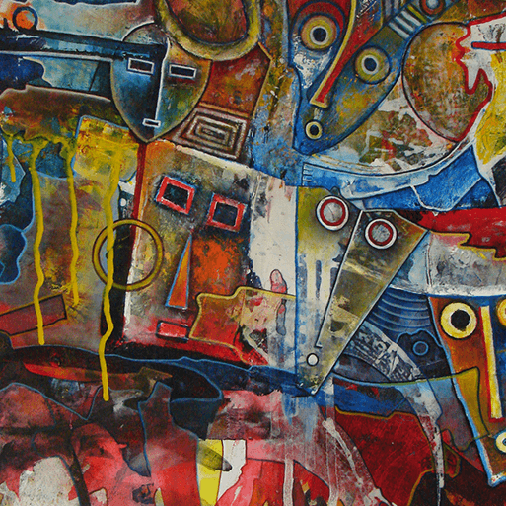 |
Year 6 - AutumnTrail Blazers, Barrier Breakers This project teaches children about significant black artists and their work and provides opportunities to analyse and create artwork inspired by them. |
 |
Year 6 - SpringInuit This project teaches children about the Inuit way of life, including some of their cultural and artistic traditions. |
 |
Year 6 - SummerBees, Beetles & Butterflies This project teaches children about sketchbooks, observational drawing, mixed-media collage, and Pop Art. They consolidate their learning to make a final piece of artwork inspired by bees, beetles, or butterflies. |
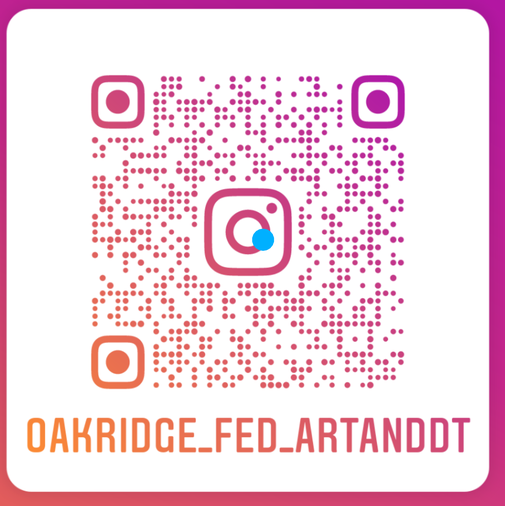 We are on Instagram! Follow the QR code or search us at oakridge_fed_artanddt
We are on Instagram! Follow the QR code or search us at oakridge_fed_artanddt
Art and DT around the school
Displays














